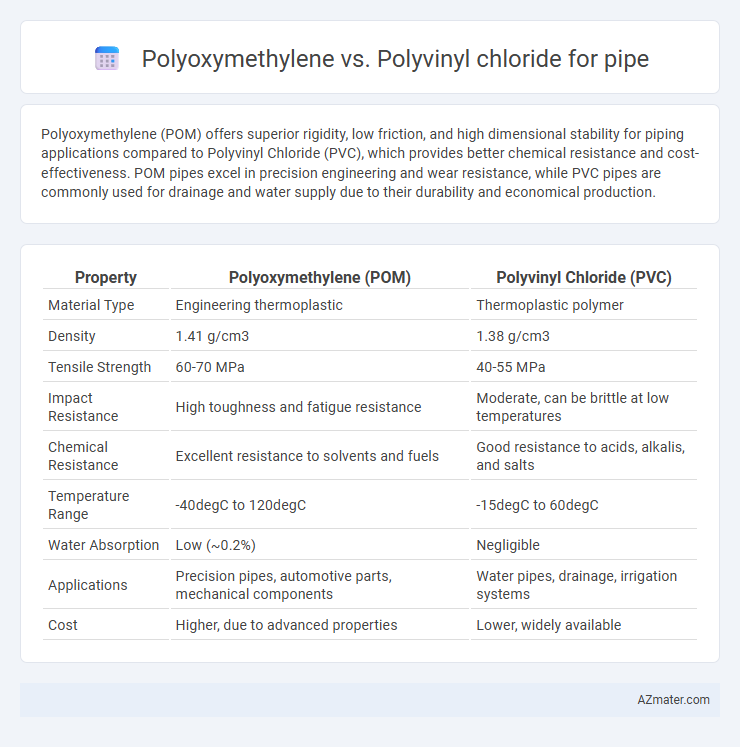Polyoxymethylene (POM) offers superior rigidity, low friction, and high dimensional stability for piping applications compared to Polyvinyl Chloride (PVC), which provides better chemical resistance and cost-effectiveness. POM pipes excel in precision engineering and wear resistance, while PVC pipes are commonly used for drainage and water supply due to their durability and economical production.
Table of Comparison
| Property | Polyoxymethylene (POM) | Polyvinyl Chloride (PVC) |
|---|---|---|
| Material Type | Engineering thermoplastic | Thermoplastic polymer |
| Density | 1.41 g/cm3 | 1.38 g/cm3 |
| Tensile Strength | 60-70 MPa | 40-55 MPa |
| Impact Resistance | High toughness and fatigue resistance | Moderate, can be brittle at low temperatures |
| Chemical Resistance | Excellent resistance to solvents and fuels | Good resistance to acids, alkalis, and salts |
| Temperature Range | -40degC to 120degC | -15degC to 60degC |
| Water Absorption | Low (~0.2%) | Negligible |
| Applications | Precision pipes, automotive parts, mechanical components | Water pipes, drainage, irrigation systems |
| Cost | Higher, due to advanced properties | Lower, widely available |
Introduction to Polyoxymethylene and Polyvinyl Chloride
Polyoxymethylene (POM) is a high-performance engineering thermoplastic known for its exceptional strength, stiffness, and low friction, making it ideal for precision pipe fittings and mechanical components. Polyvinyl Chloride (PVC) is a widely used plastic polymer characterized by its chemical resistance, durability, and cost-effectiveness, commonly applied in residential and industrial piping systems. Both materials offer distinct advantages in pipe manufacturing, with POM favored for mechanical precision and PVC for versatility and chemical resilience.
Chemical Composition and Structure Comparison
Polyoxymethylene (POM) is a highly crystalline thermoplastic polymer composed of repeating oxymethylene (-CH2O-) units, offering superior rigidity, low friction, and excellent chemical resistance, making it ideal for precision pipe applications. Polyvinyl chloride (PVC) consists of vinyl chloride monomers (-CH2-CHCl-) with a partially crystalline structure, providing strong resistance to corrosion and chemicals but with lower mechanical strength compared to POM. The fundamental difference lies in POM's carbon-oxygen backbone contributing to stiffness and wear resistance, whereas PVC's chlorine content imparts flame retardancy and durability in harsh chemical environments.
Mechanical Properties: Strength and Durability
Polyoxymethylene (POM) exhibits superior mechanical strength and high tensile resistance, making it ideal for applications requiring rigidity and dimensional stability in pipe systems. In contrast, Polyvinyl chloride (PVC) offers excellent durability with good impact resistance and flexibility, but generally has lower tensile strength compared to POM. POM pipes demonstrate enhanced fatigue resistance and wear properties, while PVC pipes maintain strong chemical resistance and long-term performance in varying environmental conditions.
Thermal Resistance and Operating Temperatures
Polyoxymethylene (POM) exhibits superior thermal resistance compared to Polyvinyl Chloride (PVC), with an operating temperature range typically between -40degC and 100degC, while PVC generally operates safely between -15degC and 60degC. POM maintains structural integrity and mechanical properties at elevated temperatures, making it suitable for applications requiring higher thermal stability. In contrast, PVC's thermal limitations restrict its use in high-temperature environments, where deformation or degradation may occur.
Chemical Corrosion Resistance
Polyoxymethylene (POM) exhibits superior chemical corrosion resistance compared to Polyvinyl Chloride (PVC), making it highly suitable for applications involving exposure to solvents, acids, and alkalis. PVC pipes tend to degrade when exposed to strong oxidizing agents and certain hydrocarbons, whereas POM maintains its mechanical integrity and resists chemical breakdown in harsh environments. The molecular structure of POM grants it enhanced resistance to hydrolysis and chemical attack, extending the lifespan of pipes in industrial and chemical processing settings.
Ease of Fabrication and Machinability
Polyoxymethylene (POM) offers superior machinability compared to Polyvinyl Chloride (PVC) due to its high rigidity and low coefficient of friction, allowing for precise cutting and shaping with minimal tool wear. PVC pipes, while easier to weld or solvent cement, can be more challenging to machine because of their lower thermal resistance and risk of melting or deformation under high-speed tooling. The ease of fabrication for POM makes it ideal for complex or high-tolerance pipe components, whereas PVC is preferred for straightforward joins and installations in plumbing systems.
Cost Analysis and Economic Considerations
Polyoxymethylene (POM) pipes typically have higher upfront material costs compared to Polyvinyl chloride (PVC) pipes but offer superior durability and chemical resistance, potentially reducing long-term maintenance and replacement expenses. PVC pipes remain more cost-effective for large-scale projects due to lower raw material prices and widespread availability, making them economically favorable for budget-sensitive applications. Evaluating project-specific factors such as lifespan requirements, environmental exposure, and installation complexity is essential for accurate cost-benefit analysis between POM and PVC pipe investments.
Environmental Impact and Recyclability
Polyoxymethylene (POM) pipes offer a lower environmental impact due to their high durability and resistance to chemical degradation, reducing the frequency of replacements and associated waste. Polyvinyl chloride (PVC) pipes, while widely recyclable through established industrial processes, contain additives such as plasticizers and stabilizers that pose environmental challenges during recycling and disposal. The recyclability of POM is limited compared to PVC, but its extended lifespan contributes to a reduced overall ecological footprint in pipe applications.
Typical Applications in Piping Systems
Polyoxymethylene (POM) is primarily used in precision piping systems requiring high stiffness, low friction, and excellent dimensional stability, such as in automotive fuel systems and industrial fluid transport. Polyvinyl chloride (PVC) dominates in plumbing, irrigation, and drainage due to its chemical resistance, durability, and cost-effectiveness. Both materials offer strong corrosion resistance, but Polyoxymethylene excels in mechanical performance, while PVC provides greater versatility in large-scale water distribution and chemical conveyance.
Conclusion: Choosing the Right Material for Pipes
Polyoxymethylene (POM) offers superior chemical resistance, low friction, and high mechanical strength, making it ideal for precision pipe applications requiring durability and reduced wear. Polyvinyl chloride (PVC) provides excellent corrosion resistance, cost-effectiveness, and ease of installation, making it suitable for general plumbing and wastewater systems. Selecting between POM and PVC depends on the specific demands of the piping application, with POM favored for high-performance uses and PVC preferred for economical, large-scale infrastructure.

Infographic: Polyoxymethylene vs Polyvinyl chloride for Pipe
 azmater.com
azmater.com